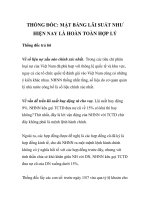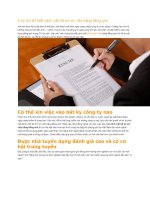LESSON 5 CASH BOOK TWO COLUMNS AND.PDF
Bạn đang xem bản rút gọn của tài liệu. Xem và tải ngay bản đầy đủ của tài liệu tại đây (273.51 KB, 12 trang )
LESSON 5: CASH BOOK: TWO COLUMNS AND
THREE COLUMNS
The objectives: After carefully studying this lesson, you should be able to:
1. use either a two-column cash book or a three-column cash book
2. appreciate how cash discount might arise
3. make accounting entries in respect of cash discount
INTRODUCTION
In this lesson, you will see that Cash book serves two purposes; it is a
book of original entry and also part of the double entry system. You will learn how
to record entries for discount received and discount allowed both in the cash
book and in the general ledger.
I.
LAYOUTS OF CASH BOOK
The Cash book combines the cash account and the bank account, using columns
but still with debits on the left and credits on the right.
This becomes a compact and convenient way of recording the receipt and
payment of money using the same rules for double – entry. It also becomes
easy to see at a glance movements between the two accounts.
There are two layouts of the Cash book: Cash book – two columns, and Cash
book – three columns.
I.1. Cash book: two columns
Dr
CASH BOOK
Date
Account Cash
name
(£)
Bank
Date
(£)
Cr
Account Cash
name
Bank (£)
(£)
I.2. Cash book: three columns
Dr
CASH BOOK
Cr
Date Account Discount Cash Bank Date Account Discount Cash Bank
name
allowed
(£)
(£)
name
(£)
received
(£)
(£)
(£)
This layout can be used when there is cash discount: discount allowed and/ or
discount received. If there is no discount, the two-column layout will be applied.
II. CASH DISCOUNT
Cash discount is an allowance to encourage payment of accounts by debtors
within a certain period.
This allowance is usually expressed as percentage, e.g. 5%, 2ẵ%, 1ẳ%.
Sales of goods on credit debtor → discount allowed
Purchases of goods on credit → creditor → discount received
II.1. Discount allowed
Discount allowed is an allowance for debtors who pay their debts within certain
time.
Discount allowed account is an expense account of the business. It will be kept
therefore in the General Ledger. At the end of the trading period its balance will
be transferred to the profit and loss account.
E.g. A Smith owed the business £1,500 for the goods sold to him on May 10,
Year 2. The terms of sale allow for 3% cash discount for payment within 7 days.
On May 15, Year 2, A Smith paid his debt by cheque.
In this example, A Smith paid his amount within required time, hence, 3% cash
discount was given to him: £1,500 x 3% = £45
Therefore, A Smith needs pay only:
£1,500 - £45 discount = £1,455
The entries for this transaction will appear in the books of accounts like this:
Sales
Year 2
May 10 A Smith
£
1,500
A Smith
Year 2
£
Year 2
£
May 10 Sales
1,500
May 15 Bank
“
Bank
15 Discount allowed
1,455
45
Year 2
£
May 15 A Smith
1,455
Discount allowed
Year 2
£
May 15 A Smith
45
The accounts will appear in the cash book like this:
Dr
Date
CASH BOOK
Accoun
Discoun
Cas
t name
t
h (£)
Bank Dat
(£)
e
Cr
Accoun
Discoun
Cas
Ban
t name
t
h (£)
k (£)
allowed
received
(£)
(£)
Year
2
May
A smith
15
1,45
45
5
II.2. Discount received
Discount received is an amount received from creditors when paying them
within required time.
Discount received account is an income account of the business. It also will be
kept in the General Ledger. At the end of the trading period its balance will be
transferred to the profit and loss account.
E.g. Suppose that the business owed L Turner £2,000 for the goods bought from
May 20th Year 2. By paying within a specified time (May 23, Year 2), the business
can receive a cash discount of 5%.
In this example, 5% cash discount was: £2,000 x 5% = £100
Therefore, the business need pay only:
£2,000 - £100 discount = £1,900
The entries for this transaction will appear in the books of accounts like this:
Purchases
Year 2
May 20 L Turner
£
2,000
L Turner
Year 2
£
Year 2
1,900
May 20 Purchases
£
May 23 Bank
2,000
“
23 Discount received
100
Bank
Year 2
May 23 L Turner
£
1,900
Discount received
Year 2
May 23 L Turner
£
100
The accounts will appear in the cash book like this:
Dr
CASH BOOK
Cr
Dat
Accoun
Discoun
Cas
Ban
e
t name
t
h (£)
k (£)
Date
Accoun
Discoun
Cas
Bank
t name
t
h (£)
(£)
allowed
(£)
received
(£)
Year
2
May
23
LTurner
1,90
100
0
The following example shows a three-column cash book for one month together
with the immediate postings to the personal accounts and the end-of-the-month
transfer of the totals of the discount columns to the general ledger.
Year 7
Oct 1 Balances brought forward:
Cash
Bank (Dr)
Debtors: T Salter
L Page
£
65
935
240
320
Creditors: M Thorne
L Barratt
180
280
“4
We pay L barratt by cheque, after deducting 2½% cash discount
273
“7
T Salter pays us by cheque, after deducting 2½% cash discount
234
“ 10
General expenses paid in cash
43
“ 15
We pay M Thorne by cheque, after deducting 5% cash discount
“ 21
Withdrew from bank for office cash
“ 27
L Page pays us by cheque, after deducting 2½% cash discount
171
60
312
Dr
CASH BOOK
Date
Account
name
Discount Cash Bank Date
allowed
(£)
(£)
Cr
Account
name
(£)
Discount Cash Bank
received (£)
(£)
(£)
Y7
Y7
Oct
1
65
935 Oct
L Barratt
7
273
4
Balances
b/d
“
7
T Salter
6
234 “ 10 General
43
Expense
“ 21 Bank C
“ 27 L Page
60
8
“ 15 M
Thorne
9
171
312 “ 21 Cash C
60
“ 31 Balances
82
997
c/d
14
Nov1 Balances
b/d
125 1,481
82
997
16
125 1,481
SALES LEDGER
T Salter
Year 7
£
Oct 1 Balance b/d
£
Year 7
240
Oct 7 Bank
Oct 7 Discount allowed
234
6
240
240
L Page
Year 7
£
Year 7
£
Oct 1 Balance b/d
320
Oct 27
Bank
Oct 7 Discount allowed
320
312
8
320
PURCHASES LEDGER
M Thorne
Year 7
£
Year 7
£
Oct 15 Bank
171
Oct 1 Balance b/d
Oct 15 Discount received
180
9
180
180
L Barratt
Year 7
£
Year 7
£
Oct 4 Bank
Oct 4 Discount received
273
Oct 1 Balance b/d
280
7
280
280
GENERAL LEDGER
General Expenses
Year 7
£
Oct 10 Cash
43
Discount allowed
Year 7
Oct 31 Sundries
£
14
Discount received
Year 7
Oct 31 Sundries
£
16
Note:
- You simply total the discount columns in the cash book. You then transfer those
totals – on the same side – to the respective discount accounts.
- C (in Cash C// Bank C): means contra- used where the double – entry is
complete within the cash book.
SUMMARY
1. The cash book is a combination of the cash accont and the bank account. It
shows columns for cash and bank on both sides.
2. The cash book is a book of original entry and also part of the double entry
records.
3. A cash discount is given to encourage prompt payment. Discount received and
discount allowed are cash discounts.
4. Discount received is an income and discount allowed is an expense.
5. The three-column cash book incorporates columns for discount allowed and
discount received on either side. The discount columns are not part of the double
entry.
6. Discount columns are totalled at the end of the month.
I hope you will be successful!
GLOSSARY
bank overdraft (n)
Thấu chi tiền gửi ngân hàng
cash discount (n)
Chiết khấu thanh toán
discount allowed (n)
Chiết khấu phải trả
discount received (n)
Chiết khấu được nhận









